Waste Management: � practical application of �the new ethical concepts of �Eco-Ethics International Union �
By : SVR Prasad
PGT Physics, KV IISc, Bangalore
What are Wastes?
Basel Convention Definition of Wastes
“substances or objects which are disposed of or are intended to be disposed of or are required to be disposed of by the provisions of the law”
Disposal means
“any operation which may lead to resource recovery, recycling, reclamation, direct re-use or alternative uses (Annex IVB of the Basel convention)”
Kinds of Wastes
Solid wastes: domestic, commercial and industrial wastes especially common as co-disposal of wastes
Examples: plastics, styrofoam containers, bottles, cans, papers, scrap iron, and other trash
Liquid Wastes: wastes in liquid form
Examples: domestic washings, chemicals, oils, waste water from ponds, manufacturing industries and other sources
Classification of Wastes according to their Properties
Bio-degradable
can be degraded (paper, wood, fruits and others)
Non-biodegradable
cannot be degraded (plastics, bottles, old machines,
cans, styrofoam containers and others)
Classification of Wastes according to�their Effects on Human Health and the Environment
Hazardous wastes
Substances unsafe to use commercially, industrially, agriculturally, or economically that are shipped, transported to or brought from the country of origin for dumping or disposal in, or in transit through, any part of the territory of the Philippines
Non-hazardous
Substances safe to use commercially, industrially, agriculturally, or economically that are shipped, transported to or brought from the country of origin for dumping or disposal in, or in transit through, any part of the territory of the Philippines
Sources of Wastes
Commerce and Industry
Agriculture
Waste Generation by Country� (Global Waste Survey Final Report Published by IMO 1995)*
* from primary and secondary industry sectors
Waste Generation in the Philippines
In Metro Manila:
- It is estimated that 25 million m 3 of acid and alkaline liquid waste is disposed of annually from the electronics industry.
- Almost 2,000 m 3 of solvents and 22,000 tonnes of heavy metals, infectious wastes, biological sludges, lubricants and intractable wastes are disposed of on land or into water courses.
- 4,000 tonnes of solid wastes are generated daily. Of these, only about 3,400 tonnes are collected and transported to existing sites.
Waste Generation in �Iloilo Province
Hundreds of tons of domestic wastes are generated daily by households contributing to the enormous environmental problems the world is facing.*
*Chua, TE (1996) Waste management in the coastal areas of the ASEAN region . ECLARM Proceedings No. 33
��EFFECTS OF WASTE IF NOT MANAGED WISELY
- Affects our health
- Affects our socio-economic conditions
- Affects our coastal and marine environment
- Affects our climate
EFFECTS OF WASTE…
According to NAS:
- GHGs are accumulating in Earth’s atmosphere as a result of human activities, causing global mean surface air temperature and subsurface ocean temperature to rise.
- Rising global temperatures are expected to raise sea levels and change precipitation and other local climate conditions.
- Changing regional climates could alter forests, crop yields, and water supplies.
- This could also affect human health, animals, and many types of ecosystems.
- Deserts might expand into existing rangelands, and features of some of our national parks might be permanently altered.
- Some countries are expected to become warmer, although sulfates might limit warming in some areas.
- Scientists are unable to determine which parts of those countries will become wetter or drier, but there is likely to be an overall trend toward increased precipitation and evaporation, more intense rainstorms, and drier soils.
- Whether rainfall increases or decreases cannot be reliably projected for specific areas.
Effects of waste….
Activities that have altered the chemical composition of the atmosphere:
- Buildup of GHGs primarily carbon dioxide (CO 2 ) methane (CH 4 ), and nitrous oxide (N 2 0).
- C0 2 is released to the atmosphere by the burning of fossil fuels, wood and wood products, and solid waste.
- CH 4 is emitted from the decomposition of organic wastes in landfills, the raising of livestock, and the production and transport of coal, natural gas, and oil.
- N0 2 is emitted during agricultural and industrial activities, as well as during combustion of solid waste and fossil fuels. In 1977, the US emitted about one-fifth of total global GHGs.
Inventory of US Greenhouse Gas Emissions and Sinks: 1990-2000, US EPA, Office of Atmospheric Programs, April 2002 EPA 236-R-02-003.
WHAT SHOULD BE DONE
- Reduce Waste
- Reduce office paper waste by implementing a formal policy to duplex all draft reports and by making training manuals and personnel information available electronically.
- Improve product design to use less materials.
- Redesign packaging to eliminate excess material while maintaining strength.
- Work with customers to design and implement a packaging return program.
- Switch to reusable transport containers.
- Purchase products in bulk.
- Reuse corrugated moving boxes internally.
- Reuse office furniture and supplies, such as interoffice envelopes, file folders, and paper.
- Use durable towels, tablecloths, napkins, dishes, cups, and glasses.
- Use incoming packaging materials for outgoing shipments.
- Encourage employees to reuse office materials rather than purchase new ones.
Donate/Exchange
- old books
- old clothes
- old computers
- excess building materials
- old equipment to local organizations
Employee Education
- Develop an “office recycling procedures” packet.
- Send out recycling reminders to all employees including environmental articles.
- Train employees on recycling practices prior to implementing recycling programs.
- Conduct an ongoing training process as new technologies are introduced and new employees join the institution.
- education campaign on waste management that includes an extensive internal web site, quarterly newsletters, daily bulletins, promotional signs and helpful reference labels within the campus of an institution.
Preventing Waste
- packaging waste reductions and changes in the manufacturing process
- use biodegradable materials
Conduct outreach program adopting an ecologically sound waste management system which includes:
- waste reduction
- segregation at source
- recycling and re-use
- more efficient collection
- more environmentally sound disposal
Residents are organized into small groups to carry out the following:
- construction of backyard compost pit
- construction of storage bins where recyclable and reusable materials are stored by each household
- construction of storage centers where recyclable and reusable materials collected by the street sweepers are stored prior to selling to junk dealers
- maintenance of cleanliness in yards and streets
- greening of their respective areas
- encouraging others to join
ENVIRONMENTAL MANAGEMENT SYSTEMS: EMS
What is an EMS?
An EMS is a formal set of policies and procedures that define how an organization will evaluate, manage, and track its environmental impact. It follows the basic model:
Plan > Do > Check > Act
This facilitates cost-effective environmental performance by defining and continuously improving the process and actions that an organization undertakes to meet its environmental goals.
EMS Development
- A Policy Statement that communicates an organization’s environmental priorities to employees.
- Managerial endorsement of the policy statement demonstrates the organization’s commitment to the effort and willingness to allocate resources for implementation.
- Once a policy statement is in place, the organization implements it following the model.
Stages in the Implementation of EMS
- understanding of eco-ethics
- environmental and health effects
- economic impacts
- liabilities
After establishing a complete list of significant aspects, the organization sets environmental goals and develops a plan to achieve those goals.
Identify all environmental aspects: any environmental or health and safety impacts resulting from activities and services. The organization then evaluates each aspect according to a variety of criteria:
The ‘do-phase’ of the model involves implementation of the environmental plan through employee training and establishment of operation controls.
Evaluates progress toward meeting program goals through ongoing monitoring and measuring and periodic EMS audits.
Involves taking corrective action to update and improve the environmental plan. For example, if an organization makes significant progress on one environmental aspect, another environmental aspect will replace it on the priority list.
Why Should an Organization Adopt an EMS?
1. Improve environmental performance
It helps monitor energy and water conservation, resource efficiencies, and pollution prevention.
2. Better regulatory compliance
Increase regulatory compliance which is especially important for organizations that spend time and resources with regulatory violations.
3. Certification and recognition
EMS implementation can enhance an organization’s image and improve public community relations.
EMS Certification
- EPA encourages organizations to use recognized EMS frameworks to improve compliance, pollution prevention, and other measures of environmental performance.
- Third-party certification can also add credibility to an organization’s EMS.
Several organizations which offer certification programs:
- American Chemistry Council
- American Forest and Paper Association
- International Chamber of Commerce
- Coalition for Environmentally Responsible Economies
- International Organization for Standardization (ISO) developed the most widely recognized EMS standard
Principles of an Effective EMS
For better environmental and overall organizational performance, an EMS should :
1. Focus on continual improvement
2. Serve the organization and its mission
3. Receive top management support
4. Remain dynamic and flexible
5. Fit the culture of the organization
6. Represent employees and their actions
7. Establish employees awareness and involvement
That ends my presentation.��I hope this lecture about ECO-ETHICS will make you aware of what is happening to our environment . ��Now I urge you to join � Eco-Ethics International Union � to help build a better house for humanity!�� Thank you for listening!
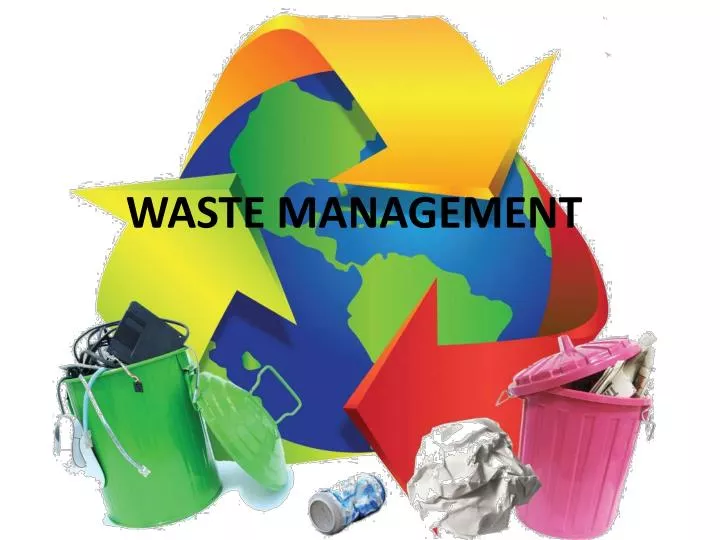

WASTE MANAGEMENT
Sep 27, 2014
6.07k likes | 13.2k Views
WASTE MANAGEMENT. Household waste. plastic, paper, glass, metal , organic waste, chemicals. Biodegradable waste : food and kitchen waste, green waste, paper (can also be recycled).
Share Presentation
- waste sorting
- organic matter
- organic waste
- changing materials waste
- company medien partner recykling

Presentation Transcript
Household waste • plastic, • paper, • glass, • metal, • organic waste, • chemicals.
Biodegradable waste: food and kitchen waste, green waste, paper (can also be recycled). Recyclable materials: paper, glass, bottles, cans, metals, certain plastics, fabrics, clothes, batteries etc. Inert waste: construction and demolition waste, rocks, debris.
The question is: what can we do??? We can: REDUCE, REUSE, RECYCLE.
What is the best way to dispose of waste? • Waste incineration is the method of neutralising municipal solid waste; (energy is gain in this process) • For many years domestic waste is incinerated in company - MEDIEN PARTNER RECYKLING in Poland
COMPOSTING • Composting of municipal solid waste is the method of organic matter recovery. • Compost is organic matter that has been decomposed and recycled as a fertilizer. Compost can be rich in nutrients and it’s a key ingredient in organic farming. It is usually used in gardens.
RECYCLING Recycling is a process of: • changing materials (waste) into new products to prevent waste of potentially useful materials, • reducing energy usage, • reducing air pollution (from incineration) and water pollution (from land filling)
WASTE SORTING Waste sorting is the process by which waste is separated into different elements .
Paper, newspapers, notebooks, paper bags, carboard. colourful glass, jars, bottles and glass packaging.
glass bottles, cosmetic packaging.
WILD waste dumps Wild waste dumps come into being in the forestes and near our riversandcause dangerous water and soil contamination.
Wild waste dump is the source of: • dangerous soil pollution, • water contamination, • epidemic of dangerous illness • weak trees condition • biogases lightening • emision of CO2, NH4, H2S • ecosystems disturbing • destroying the natural environment • deformation of the ground
Ecological Campaigns in Zawiercie
An expansion of Municipal Waste Company in Zawiercie. The main aim of this project was to reduce the amount of waste and increase an ecological awarness. Waste sorting advertisement in Zawiercie.
ECOLOGICAL CAMPAIGNS IN OUR SCHOOL • In 2012 our school took part in ecological competition „ BATTERIES COLLECTION” – 12th edition. We won the first prize and were very proud. Every year we also „Clean the World”
ECOLOGICAL CAMPAIGNS IN OUR SCHOOL • In 2012 our school took part in the ecological competition „ BATTERIES COLLECTION” – 12th edition. We won the first prize and were very proud. Every year we also „Clean the World”
Water treatment
The Sewage Treatment Farm in Zawiercie The Sewage Treatment Farm in Zawiercie was built at the turn of the 1960s and 1970s, and was modernized in 1993-1998 and for second time in 2008-2009.
Its objective is to purify sewage in a process of removing impurities from wastewater and household sewage both runoff (effluents), domestic, commercial and institutional. It includes mechanical and biological processes to remove chemical and biological contaminants.
During the first mechanical treatment process of filtration constant pieces and sediments are removed by using all kinds of bars and sieves.
Biological treatment process is based on nitrification and denitrification The purpose of this process is to reduce the amount of nitrogen, phosphate and sediments. After that treated sewage is discharged to the environment – the Warta River.
In this technological process two kinds of sediments come into being, then they are treated in the process of fermentation in a closed fermentation tank. The final product of this process is biogas that can be used as a fuel, for any heating purpose.
Our trip to the sewage treatment farm In May our guests from Spain, Malta, Tukey, Slovenia, Italy, Portugal, France, Romania and pupils from our school visited The Sewage Treatment Farm. We could learn about biological and mechanical processes of puryfing water.
What’s your choice?
- More by User
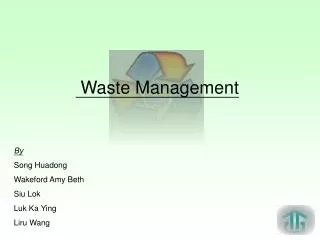
Waste Management
Waste Management. By Song Huadong Wakeford Amy Beth Siu Lok Luk Ka Ying Liru Wang. Sector – Waste. Reasons for choosing waste as our sector:. International Scale
1.54k views • 25 slides

Waste Management. Department of Fisheries and Aquatic Resources (DFAR) Sri Lanka. National Aquatic Resources Research and Development Agency (NARA) Sri Lanka. United Nations University Fisheries Training Programme (UNU-FTP) Iceland. Icelandic International Development Agency (ICEIDA)
1.75k views • 27 slides

Waste Waste Management
1.52k views • 17 slides

Waste Management. Joe Barbish. Water Usage. Lane Kurkjian. Paper Usage. Maria Bajzek. Energy Usage. Nadia Sheen.
340 views • 4 slides

Waste Management. It is the collection , transportation, processing or disposal, managing and monitoring of waste materials. What is Waste Management?. Distinct practice from resource recovery which focuses on delaying the rate of consumption of natural resources. .
4.88k views • 16 slides

Waste Management . Obj - Discuss sources and types of waste. Waste Disposal. Solid waste disposal is a problem in this country It is considered by some to be the most pressing environmental problem . Solid Waste Sources . Solid waste: non-liquid, non-soluble materials
502 views • 10 slides
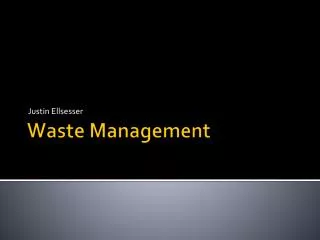
Justin Ellsesser. Waste Management. Bought 79 shares at $34.79 on April 8, 2008 Current Price: $36.54 Holding Return: 5 % YTD return: 8% Morningstar Intrinsic Value: $37. Recent News. Company announced a 4.5% dividend yield
290 views • 6 slides
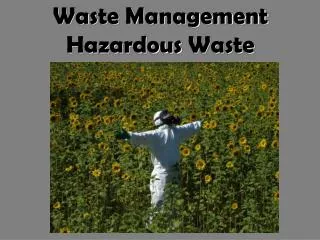
Waste Management Hazardous Waste
Waste Management Hazardous Waste. The topics of today. Rules and regulations Hazardous Waste Dangerous Goods Security advisement The work of SEKA Miljöteknik Laboratory waste Questions , comments , views and ideas. Askewed balance - Environmental changes. Organization.
1.14k views • 27 slides

Waste Management. WM. Spills. Routine or Non-Routine Waste Generation Activities. Remediation/Construction Projects. Hazardous Waste. Hazardous waste is managed in a manner consistent with regulations 90 day generator Yearly County inspections with potential for violations
812 views • 24 slides

Waste Management. External Supplier User Guide. SciQuest USA, Inc 5433 Westheimer Ste 925 Houston, TX 77056 1-800-233-1121. Table of Contents. Getting Started............................................................................... 3
528 views • 19 slides

Waste Management. By: Krystal Brostek. What’s the Issue. Waste from animal agriculture is an increasing environmental problem.
311 views • 6 slides

Waste Management . Resource Conservation and Recovery Act 42 U.S.C. § 321 et seq. (1976). Waste Management and Pollution Control . Hierarchy of Waste Management Pollution Prevention Waste Reduction Recycle Treatment Disposal Pollution Prevention Act of 1990. Predecessor Laws.
893 views • 50 slides

Waste Management. A Brief History of Waste Disposal:. The Early Years: “Dilute and Disperse”. -Waste production was taken care of by dumping, either into unused land areas (“swamps”) or into rivers. Many cities have areas that once were “dumps”, and are now covered by parks or buildings.
1.05k views • 40 slides

Waste Management. By Faez Wei Qian Archita Jae-Eon Eun-jin Ann Thanh Hang. Introduction. E- waste. Contains toxic chemicals Sickness Disposal Externalizing cost Designing for the dump. Household Waste. From houses Two types: Hazardous Non-hazardous Three problems:
515 views • 9 slides

WASTE MANAGEMENT. Chapter 19. Love Canal, New York When Waste is Not Disposed of Properly. 1942 to 1958 Hooker Chemicals Disposal Site 1953 Sold to Niagara Falls School Board (school, housing) 1976 Residents becoming sick 1978 Lois Gibbs leads outcry 1980 Declared Disaster Site
1.65k views • 80 slides

Waste management
Waste management. Recycling :. - Running ou t of resources. - Less resources on production. Copenhagen Waste Management Plan - 2012.
242 views • 2 slides
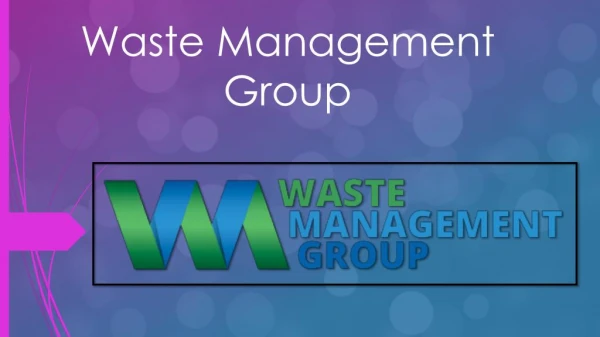
Waste Management Services-Waste Management Group
Waste Management Group are dedicated to finding alternative uses for all construction waste material. We care about our environment, and we are focused on becoming a market leader in the construction and demolition debris recycling industry. With Skip Bins and large volume Hook Bins for hire, and a centrally located Transfer Station in Molendinar, Waste Management Group provides a total waste and recycle service covering the Yatala to Northern Rivers. Professional and reliable, our services include prompt collection and recycle, or we accept and process commercial waste from waste collectors via our best guarantee tipping service.For More Info Check Our Website:-https://wmgroup.com.au
288 views • 9 slides

Waste Management. Clark County School District Laboratory and Chemical Waste Storage Area Safety Training. Waste Regulations. 1976, Resource Conservation and Recovery Act (RCRA)
402 views • 31 slides

Waste Management. Environment. Water Organic Matter Plant Nutrients Salt. Water Food Air Energy. Environment. Manure components may be positives or pollutants. Manure components may be positives or pollutants …. It all depends on how and when they reenter the environment.
893 views • 71 slides

Waste Management. 19. CHAPTER. Talk About It Which should play a greater role in reducing the waste we generate—personal choices by consumers or government regulation?. Transforming New York’s Fresh Kills Landfill.
413 views • 19 slides
Solid waste management ppt
The document discusses solid waste management. It defines different types of solid waste and their effects. It describes concepts of waste management including reduce, reuse and recycle. Methods of solid waste storage, collection, transport, disposal and technologies are explained. Recommendations are made to improve waste management through increased public awareness, prohibiting littering, and moving from open dumping to sanitary landfilling. Read less
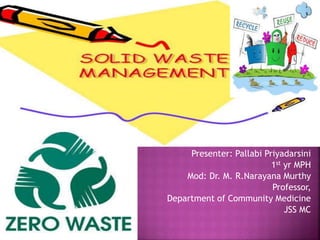
More Related Content
- 1. Presenter: Pallabi Priyadarsini 1st yr MPH Mod: Dr. M. R.Narayana Murthy Professor, Department of Community Medicine JSS MC
- 2. Introduction to waste and types Solid waste Types of solid waste Effects of solid waste Waste management concept Concept of 3R solid waste management storage collection waste handling and transport method of disposal Technology Zero waste system Recommendation
- 3. It is defined as Waste (also known as rubbish, trash, refuse, garbage, junk) is any unwanted or useless materials. OR Any materials unused and rejected as worthless or unwanted and “A useless or profile less activity using or expanding or consuming thoughtlessly or carefully.”
- 4. Solid waste Liquid waste Gaseous waste Animal by product(ABPs) Biodegradable waste Chemical waste Commercial waste/ Business waste Biomedical waste Bulky waste
- 5. It is defined as “ non liquid, non-soluble materials ranging from municipal garbage to industrial wastes that contain complex & sometimes hazardous substances” Solid waste also include Garbage Rubbish Demolition products Sewage treatment residue Dead animals Manure and other discarded material. -- Per capita solid waste out put 0.25-2.5 Kg/day
- 6. Agriculture Fisheries Household Commerce and industry
- 7. Broadly there are 3 types of waste which as follows 1. Household waste as municipal waste 2. Industrial waste as hazardous waste 3.Biomedical waste or hospital waste as infectious waste
- 8. Municipal solid waste consist of--- household waste construction and demolition debris sanitation residue waste from streets With rising urbanization and change in life style and food habits ,the amount of municipal solid waste has been increasing rapidly and its composition changing.
- 10. Industrial and hospital waste is considered hazardous as they may contain toxic substances Hazardous waste could be highly toxic to humans, animals and plants. They are - corrosive - highly inflammable or explosive In the industrial sector the major generators of hazardous waste are the metal’ chemical’ paper, pesticide, dye and rubber goods industries. Direct exposure to chemicals in hazardous waste such as mercury and cyanide can be fatal
- 11. Bio-medical waste means “Any waste which is generated during the diagnosis, treatment or immunization of human beings or animals or in research activities pertaining thereto or in the production or testing of biological” -Bio-medical waste rules ,1998 It may includes wastes like sharp waste, pathological waste, pharmaceutical waste, genotoxic waste, chemical waste, and radioactive waste etc.
- 12. A:Health hazard If solid waste are not collected and allowed to accumulate , they may create unsanitary conditions. This may lead to epidemic outbreaks . Many diseases like cholera. Diarrhea, dysentery, plague, jaundice, or gastro-intestinal diseases may spread and cause loss of human lives.
- 13. In addition improper handling of the solid wastes ,a health hazard for the workers who come in direct contact with the waste. B: Environmental impact If the solid wastes are not treated properly decomposition and putrefaction( decay) may take place . The organic solid waste during decomposition may generate obnozious (intolerable odour)
- 14. The 3Rs (Reduce, Reuse, Recycle) to be followed for waste management.
- 15. Disposable goods: paper plate, paper bowl, Styrofoam cup, plastic spoon, roll of paper towels, paper napkin; Durable goods: ceramic/plastic plate, metal spoon, glass/plastic drinking cup, dish towel, cloth napkin) Recovery of one tonne paper can save 17 trees.
- 16. Instead of buying new containers from the market, use the ones that are in the house. Don’t through away the soft drink can or bottle cover them with home made paper or paint on them and use them as pencil stands or small vases.
- 17. Use shopping bags made of cloth or jute which can be used over and over
- 19. There are a number of concepts about waste management which vary in their usage between countries or regions. Some of the most general, widely used concepts include: 1. Waste hierarchy - The waste hierarchy refers to the "3 Rs" reduce, reuse and recycle, which classify waste management strategies according to their desirability in terms of waste minimization. The waste hierarchy remains the cornerstone of most waste minimization strategies. • The aim of the waste hierarchy is to extract the maximum practical benefits from products and to generate the minimum amount of waste .
- 21. Polluter pays principle - the Polluter Pays Principle is a principle where the polluting party pays for the impact caused to the environment. With respect to waste management, this generally refers to the requirement for a waste generator to pay for appropriate disposal of the unrecoverable material.
- 22. Waste management is the storage collection transport and handling recycling disposal and monitoring of waste materials.
- 23. Storage: - Galvanized steel dust bin - Paper sack - Public bins
- 24. Collection - House-to-house collection - Collection from the public bins
- 25. Waste handling and separation involves activities associated with waste management until the waste is placed in storage containers for collection. Handling also encompasses the movement of loaded containers to the point of collection. waste is transferred from a smaller collection vehicle to larger transport equipment
- 26. Recycling refers to the collection and refuse of waste materials such as empty beverage container. The materials from which the items are made can be processed into new products. Materials for recycling may be collected separately from general waste using dedicated bins.
- 27. 1. Dumping 2. Controlled Tipping or Sanitary Landfill 3. Incineration 4. Composting 5. Manure pits 6. Burial
- 28. Public hygiene and health. Reuse, recovery and recycle Energy generation Sustainable development Aesthetics
- 29. Low lying areas. Mainly for dry refuses Kolkata disposes by this method and reclaimed land given for cultivation. Unsanitary method - Exposed to flies and rodents - Nuisance - Dispersed by wind - pollution of surface water
- 30. Satisfactory method - Material placed in a trench - compacted with earth at the end of the working day. Modified sanitary land fill-where compaction and covering are accomplished once or twice a week.
- 31. 3 Methods 1. Trench method 2. Ramp method 3. Area method Refuse is compacted on its exposed surface with excavated earth (30 cm).
- 32. Long trench of 6-10 feet deep and12-36 feet wide. Refuse is compacted and covered with excavated earth. Refuse is filled up to 6 feet. It is estimated one acre of land per year for 10,000 population. RAMP METHOD: suited where the terrain is moderately slopping.
- 33. Used for filling land depressions, disused quarries and clay pits. Refuse is deposited, packed and consolidated in uniform layers for 6-8 feet. Each layer is sealed with a mud cover at least 12 inches. Sealing prevents infestation by flies and rodents. Prevents nuisance of smell and dust.
- 34. Changes - Chemical - Bacteriological - Physical The temperature rises to over 60 deg. C within 7 days and kills all pathogens and hastens the decomposition process. It takes 4 to 6 months for complete decomposition.
- 38. it is a disposal method in which solid organic wastes are subjected to combustion so as to convert them into residue and gaseous products. This process reduces the volumes of solid waste to 20-30% of the original volume. Also described as thermal treatment Where land is not available Hospital waste
- 39. Method of combined disposal of refuse and night soil/ sludge Principal by products are: CO2 , Water and heat End product- compost Methods a. Bangalore method b. Mechanical composting c. Vermicomposting
- 41. IISc- Indian Council of Agricultural Research. Trenches are dug 3ft deep, 5-8ft broad, 15-30ft long. Composting procedure - 1. Layer of Refuse- 15 cm - 2. Layer of Night soil – 5 cm Physical, chemical and biological changes takes place
- 42. Compost manufactured by processing raw materials. 1. Screening 2. Pulverization (<2inches) 3. Mixing 4. Incubation Process completed in 4-6 week C: vermicomposting :It is a method of disposal of kitchen and plate wastes, which serves the dual purpose of disposing off the garbage as well as proving eco-friendly.
- 43. Mostly used in rural areas Digging “manure pits” is to prevent the refuses thrown around the houses. The garbage, cattle dung, straw, and leaves should be dumped into the mannure pits and covered with earth. Two pits will be needed In 5-6 month’s time the refuse is converted into manure which can be returned to the field.
- 44. Suitable for small camp A trench 1.5m wide &2 m deep is excavated The refuse is covered with 20 -30cm of earth When the level in the trench is 40cm from ground level, the trench is filled with earth & compacted 4-6 months
- 45. Technologies like RFID( Radio frequency identification) tags are now being used to collect data on presentation rates for curb-side pick-ups. GPS tracking is particularly evident when considering the efficiency of ad hoc pick-ups (like skip bins or dumpsters) where the collection is done on a consumer request basis. Rear vision cameras are commonly used for OH&S (Occupational Health & Safety) reasons and video recording devices are becoming more widely used, particularly concerning residential services.
- 46. Zero waste system which was founded by PhD chemist .Paul parmer in Okland. It is a philosophy that encourages the redesign of resource life cycle so that all products are reused.
- 48. There are two solid waste management plant in Mysore. J.P Nagar vidyaranyapuram
- 50. BBMP represents the third level of government & forth largest municipal corporation in India . It is responsible for the development of the city , health hygiene, licensing trade & education.
- 52. Environment protection act, 1986 Hazardous waste rule 1989 Bio-medical waste rule 1998 Municipal solid waste rule 2000 Waste management act 1996 Solid waste policy in India 2006
- 53. The improvement of people and private sector through NGOs could improve the efficiency of solid waste management. Public awareness should be created especially at primary level. Littering of solid waste should prohibited in cities towns and urban areas. More over house to house collecting solid waste should be .
- 54. The collection bins must be have a large enough capacity to accommodate 20% more than the expected waste generation in the area. Municipal authorities should maintain the storage facilities to avoid unhygienic & unsanitary condition. It is advisable to move from open dumping to sanitary land filling in a phased manner.
- 55. Park K. Park’s Textbook of Preventive and Social Medicine. 22nd ed. Jabalpur: Banarsidas Bhanot Publishers; 2013. Chapter 20, Communication for Health Education; p699-701 Bhalwar, Rajvir et al, 2009, Textbook of Public Health and Community Medicine, Prune, WHO/AFMC;p715- 717 BK Mahajan. (2011) Text book of preventive and social medicine. 7th Edition. Jaypee Brothers Medical Publishers (P) Ltd., Daryaganj, New Delhi.;p71-73 AH Suryakantha. Community Medicine With Recent Advances. 3rd Edition. Jaypee Brothers Medical Publishers (P) Ltd., Daryaganj, New Delhi; 2013;p233- 237

- Collections
Renewable Energy
- Waste Management
Easily Edit Waste Management PPT And Google Slides Templates

Waste Management Presentation Slides
Features of this templates.
- 100% customizable slides and easy to download.
- The slide contains 16:9 and 4:3 formats.
- Easy to change the colors of the slide quickly.
- Highly compatible with PowerPoint and Google Slides.
- E-Waste Management
- Wastage Management
- Waste Disposal And Recycling
- Waste Management System
- Waste Management Industry
- Google Slides

25+ Templates

270+ Templates

129+ Templates

Agriculture
65+ Templates

53+ Templates

13+ Templates

67+ Templates

70+ Templates

56+ Templates

32+ Templates
You May Also Like These PowerPoint Templates

JavaScript seems to be disabled in your browser. For the best experience on our site, be sure to turn on Javascript in your browser.
Newly Launched - AI Presentation Maker

AI PPT Maker
Powerpoint Templates
PPT Bundles
Kpi Dashboard
Professional
Business Plans
Swot Analysis
Gantt Chart
Business Proposal
Marketing Plan
Project Management
Business Case
Business Model
Cyber Security
Business PPT
Digital Marketing
Digital Transformation
Human Resources
Product Management
Artificial Intelligence
Company Profile
Acknowledgement PPT
PPT Presentation
Reports Brochures
One Page Pitch
Interview PPT
All Categories
Top 10 Waste Management Process PowerPoint Presentation Templates in 2024
The Waste Management Process is a crucial aspect of environmental sustainability, encompassing a series of steps designed to handle waste efficiently from its generation to its final disposal. This process typically includes waste generation, collection, transportation, treatment, and disposal. By utilizing well-structured presentations in PowerPoint (PPT), organizations can effectively communicate the intricacies of waste management to various stakeholders, including employees, policymakers, and the community. PPT presentations can visually represent complex data, such as waste generation statistics, recycling rates, and the environmental impact of waste. They can also outline best practices for waste segregation, reduction, and recycling, making it easier for audiences to grasp the importance of responsible waste management. Furthermore, engaging visuals and infographics can highlight innovative waste treatment technologies and their benefits, fostering a deeper understanding of the subject. Training sessions and workshops can be enhanced with PPT presentations that incorporate interactive elements, such as quizzes or case studies, to encourage participation and retention of information. Ultimately, the use of PowerPoint in waste management education and advocacy serves to promote awareness, drive community engagement, and support the development of sustainable waste management strategies that contribute to a cleaner and healthier environment.

Waste management process diagram powerpoint topics
Presenting waste management process diagram powerpoint topics. Presenting waste management process diagram powerpoint topics. This is a waste management process diagram powerpoint topics. This is seven stage process. The stages in this process are recycling, energy, recycling and reuse, waste removal, storage and collection, waste transportation.
Don't give differences a chance to develop with our Waste Management Process Diagram Powerpoint Topics. Eliminate any cause for dispute.
- Recycling And Reuse
- Waste Removal
- Storage And Collection
- Waste Transportation
Related Products

Waste Management Powerpoint Ppt Template Bundles
Engage buyer personas and boost brand awareness by pitching yourself using this prefabricated set. This Waste Management Powerpoint Ppt Template Bundles is a great tool to connect with your audience as it contains high-quality content and graphics. This helps in conveying your thoughts in a well-structured manner. It also helps you attain a competitive advantage because of its unique design and aesthetics. In addition to this, you can use this PPT design to portray information and educate your audience on various topics. With twenty slides, this is a great design to use for your upcoming presentations. Not only is it cost-effective but also easily pliable depending on your needs and requirements. As such color, font, or any other design component can be altered. It is also available for immediate download in different formats such as PNG, JPG, etc. So, without any further ado, download it now.
Our Waste Management Powerpoint Ppt Template Bundles are topically designed to provide an attractive backdrop to any subject. Use them to look like a presentation pro.
- Solid Waste
- Waste Management Plan
- Healthcare Solid Waste Management

Eco Friendly Technology Powerpoint Ppt Template Bundles
Deliver a credible and compelling presentation by deploying this Eco Friendly Technology Powerpoint Ppt Template Bundles. Intensify your message with the right graphics, images, icons, etc. presented in this complete deck. This PPT template is a great starting point to convey your messages and build a good collaboration. The seventeen slides added to this PowerPoint slideshow helps you present a thorough explanation of the topic. You can use it to study and present various kinds of information in the form of stats, figures, data charts, and many more. This Eco Friendly Technology Powerpoint Ppt Template Bundles PPT slideshow is available for use in standard and widescreen aspects ratios. So, you can use it as per your convenience. Apart from this, it can be downloaded in PNG, JPG, and PDF formats, all completely editable and modifiable. The most profound feature of this PPT design is that it is fully compatible with Google Slides making it suitable for every industry and business domain.
Introducing our comprehensive PowerPoint presentation on Eco Friendly Technology, a dynamic resource that delves into the cutting edge world of eco-friendly technology and clean, energy efficient solutions. This engaging PPT showcases the latest developments in Green Energy Technology and highlights eco conscious innovations that are transforming industries worldwide. With a focus on sustainability and environmental responsibility, our presentation offers invaluable insights into the ever evolving landscape of clean technology. Explore the forefront of energy efficient solutions and gain a deeper understanding of how eco-friendly technology is shaping the future. Whether you re an industry professional, educator, or simply interested in the green tech revolution, this PPT will empower you with knowledge and ideas to champion a more sustainable and environmentally conscious world.
- Green Energy Technology
- Eco Friendly Technology
- Clean Technology
- Energy Efficient Solutions
- Eco Conscious Innovations

Solid waste management process flow
Presenting this set of slides with name Solid Waste Management Process Flow. The topics discussed in these slides are Central Storage Facility, Product Utilisation, Warehouse, Process Flow, Assemble Solid Waste, Solid Waste Generation. This is a completely editable PowerPoint presentation and is available for immediate download. Download now and impress your audience.
Elevate the level of your discussion. Give it a lift with our Solid Waste Management Process Flow.
- Central Storage Facility
- Product Utilisation
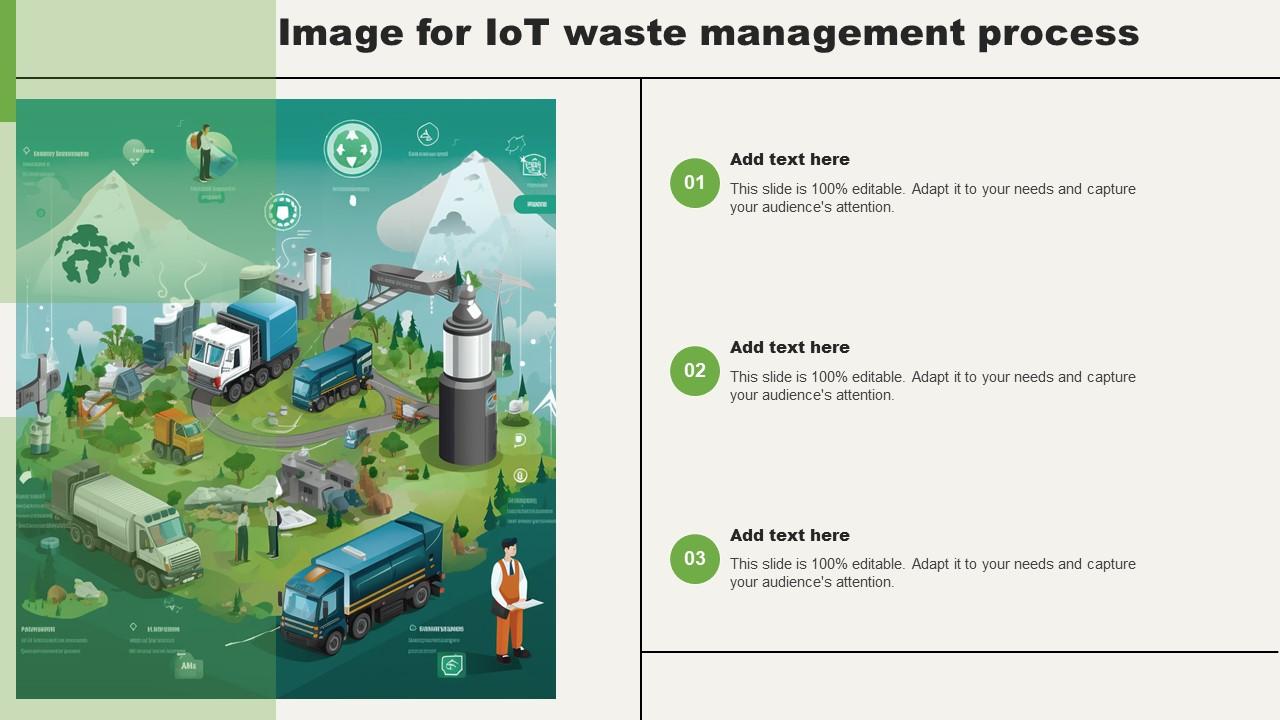
Image For IoT Waste Management Process
Introducing our Image For IoT Waste Management Process set of slides. The topics discussed in these slides are Image For IoT Waste, Management Process. This is an immediately available PowerPoint presentation that can be conveniently customized. Download it and convince your audience.
Our Image For IoT Waste Management Process are topically designed to provide an attractive backdrop to any subject. Use them to look like a presentation pro.
- Image For Iot Waste
- Management Process

IoT Urban Smart Waste Management Process
The following slide represents the urban waste management process using IoT technology and connected devices that helps to collect and deploy the waste for building a sustainable and smart city. The steps involved are access to energy sources, garbage cans with active sensors, etc. Introducing our IoT Urban Smart Waste Management Process set of slides. The topics discussed in these slides are City Council, Recycling Plant, Manufacturing Plant. This is an immediately available PowerPoint presentation that can be conveniently customized. Download it and convince your audience.
The following slide represents the urban waste management process using IoT technology and connected devices that helps to collect and deploy the waste for building a sustainable and smart city. The steps involved are access to energy sources, garbage cans with active sensors, etc.
- City Council
- Recycling Plant
- Manufacturing Plant

Smart Waste Management Process To Reduce Carbon IoT Driven Waste Management Reducing IoT SS V
This slide comprises of smart waste management process that leads to less fuel consumption and ultimately reduces carbon footprint. It includes steps such as collection of data from devices, convert data into insights, align sensors for collection volume and disposal procedure, etc. Increase audience engagement and knowledge by dispensing information using Smart Waste Management Process To Reduce Carbon IoT Driven Waste Management Reducing IoT SS V. This template helps you present information on five stages. You can also present information on Smart Waste Management Process, Reduce Carbon Footprint, Allow Smart, Intelligent using this PPT design. This layout is completely editable so personaize it now to meet your audiences expectations.
This slide comprises of smart waste management process that leads to less fuel consumption and ultimately reduces carbon footprint. It includes steps such as collection of data from devices, convert data into insights, align sensors for collection volume and disposal procedure, etc.
- Smart Waste Management Process
- Reduce Carbon Footprint
- Allow Smart
- Intelligent
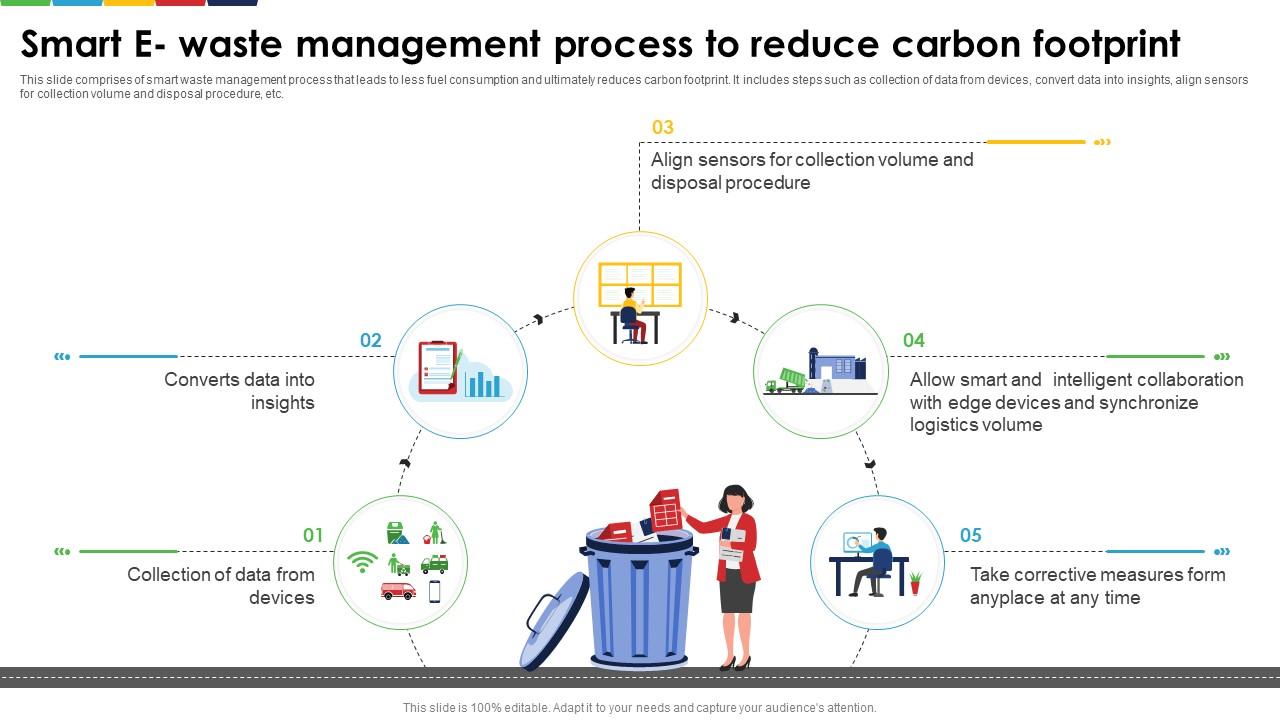
Smart E Waste Management Process To Reduce Carbon Footprint Enhancing E Waste Management System
This slide comprises of smart waste management process that leads to less fuel consumption and ultimately reduces carbon footprint. It includes steps such as collection of data from devices, convert data into insights, align sensors for collection volume and disposal procedure, etc. Deliver an outstanding presentation on the topic using this Smart E Waste Management Process To Reduce Carbon Footprint Enhancing E Waste Management System Dispense information and present a thorough explanation of Converts Data, Devices, Logistics Volume using the slides given. This template can be altered and personalized to fit your needs. It is also available for immediate download. So grab it now.
- Converts Data
- Logistics Volume
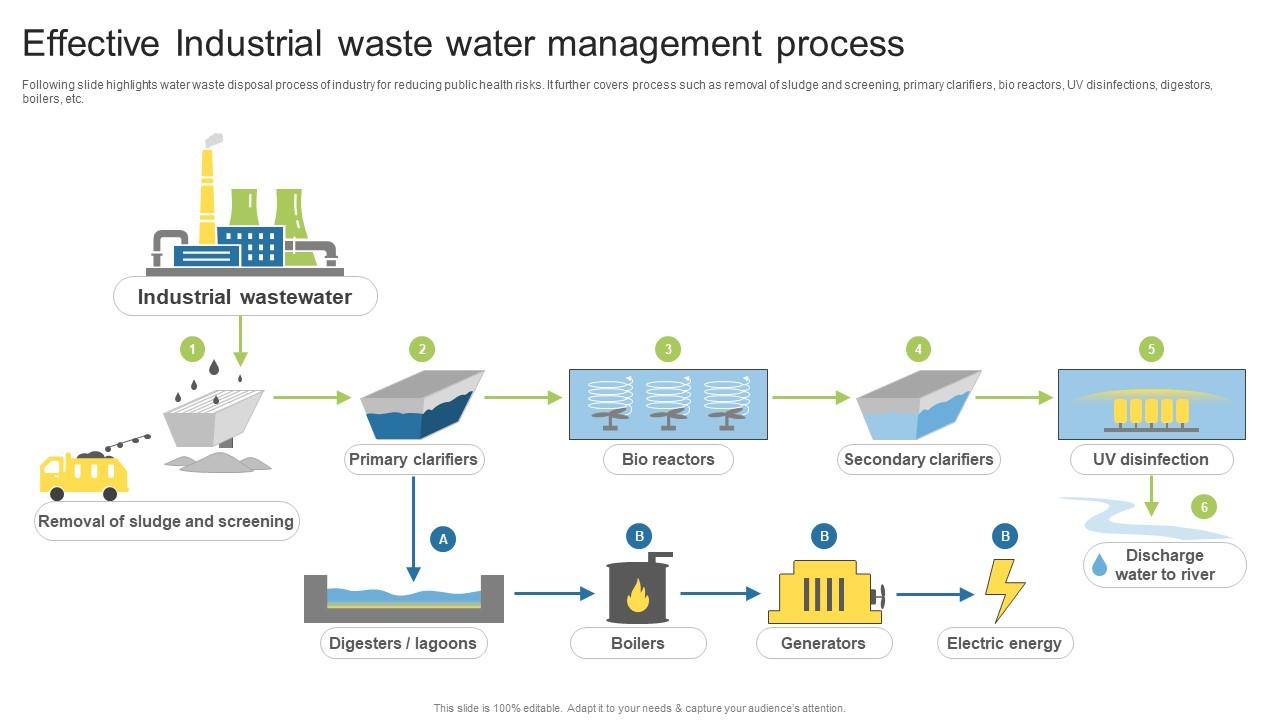
Effective Industrial Waste Water Management Process
Following slide highlights water waste disposal process of industry for reducing public health risks. It further covers process such as removal of sludge and screening, primary clarifiers, bio reactors, UV disinfections, digestors, boilers, etc. Presenting our well structured Effective Industrial Waste Water Management Process The topics discussed in this slide are Industrial Wastewater, Primary Clarifiers, Bio Reactors This is an instantly available PowerPoint presentation that can be edited conveniently. Download it right away and captivate your audience.
Following slide highlights water waste disposal process of industry for reducing public health risks. It further covers process such as removal of sludge and screening, primary clarifiers, bio reactors, UV disinfections, digestors, boilers, etc.
- Industrial Wastewater
- Primary Clarifiers
- Bio Reactors

Smart E Waste Management Process To Reduce Tep By Step Process For E Waste Ppt Sample
This slide comprises of smart waste management process that leads to less fuel consumption and ultimately reduces carbon footprint. It includes steps such as collection of data from devices, convert data into insights, align sensors for collection volume and disposal procedure, etc. Introducing Smart E Waste Management Process To Reduce Tep By Step Process For E Waste Ppt Sample to increase your presentation threshold. Encompassed with five stages, this template is a great option to educate and entice your audience. Dispence information on E Carbon Footprint, Collection Volume And Disposal Procedure, Collection Of Data From Devices, using this template. Grab it now to reap its full benefits.
- E Carbon Footprint
- Collection Volume And Disposal Procedure
- Collection Of Data From Devices

Home PowerPoint Templates Waste Management
Waste Management PowerPoint Templates
Waste Management is a crucial topic in today’s world since organizations all over the world are campaigning to save this planet. Our PowerPoint templates of waste management target important aspects of pollution and environmental risk.
These PowerPoint Waste Management Templates include shapes and diagrams to structure presentation topics, as well as ecology and recycling concepts using metaphor graphics. Users can edit and fill these environmental slides with useful information to educate the audience about saving the planet. Download now!
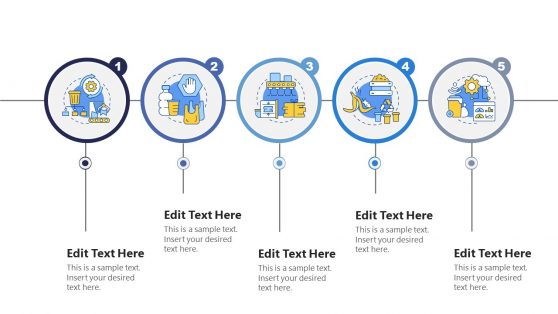

5-Step Horizontal Infographic Diagram for PowerPoint
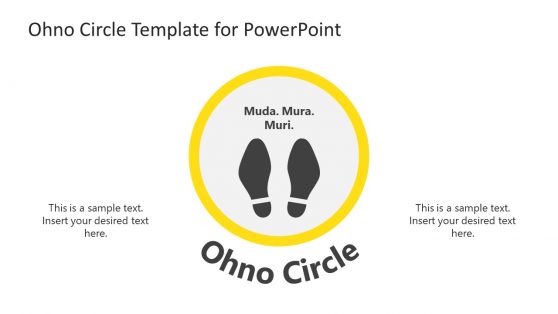
Ohno Circle PowerPoint Template
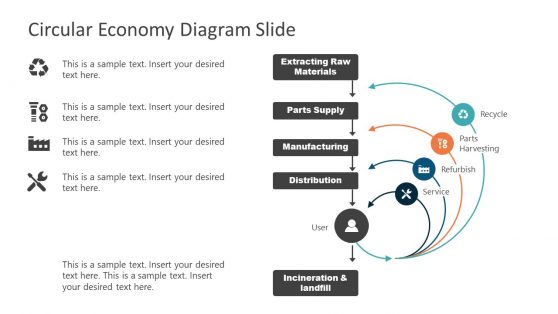
Circular Economy Diagram Slide for PowerPoint
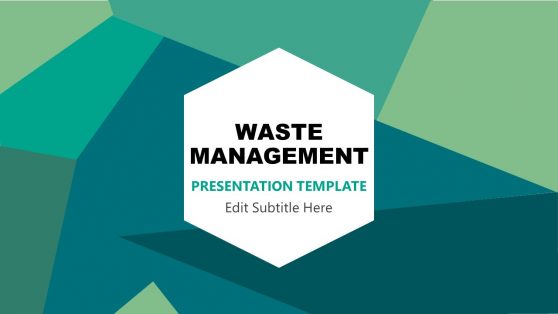
Waste Management Industry PowerPoint Template
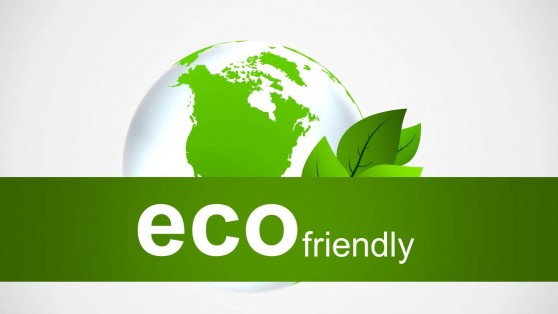
Eco Friendly PowerPoint Template with Recycle Icons
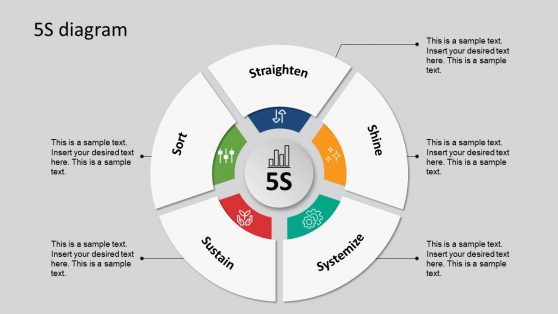
5S Framework PowerPoint Diagram
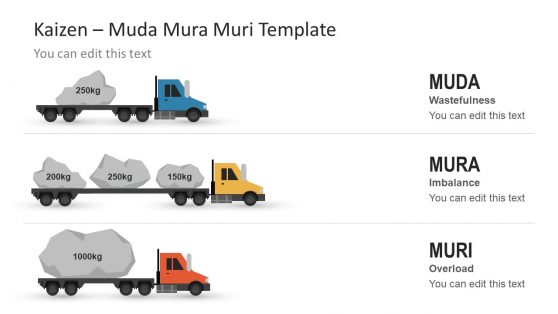
Kaizen Muda Mura Muri Template for PowerPoint
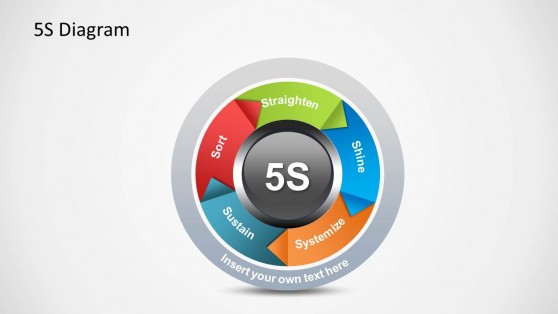
5S Diagram Template for PowerPoint
Using a waste management PPT template simplifies the process of creating an engaging and informative presentation. These templates come pre-designed with sections for key topics such as waste reduction, recycling, landfill management, and hazardous waste handling. Visuals like flowcharts, diagrams, and graphs make it easy to communicate data and strategies clearly. Whether you’re addressing a corporate audience, government body, or community group, these templates ensure that your message is not only understood but also impactful.
Waste management presentation templates are perfect for environmental consultants, sustainability managers, educators, and public officials. Use them to present data on recycling initiatives, explain waste segregation protocols, or outline sustainable waste solutions for businesses.
What is a waste management presentation template?
A waste management presentation template is a pre-designed PowerPoint layout used to communicate strategies for managing, reducing, and recycling waste. It includes slides for key areas such as waste segregation, landfill management, and sustainable practices.
How do you create a waste management PowerPoint template?
To create a waste management PowerPoint template, structure your presentation to include sections on waste types, segregation processes, recycling programs, and sustainability strategies. Use visuals like flowcharts, data graphs, and diagrams to explain concepts clearly. For a quicker solution, download a customizable waste management PPT template from SlideModel.
Where do I find a free waste management presentation template?
You can find free waste management presentation templates on SlideModel, offering customizable slides to present waste management strategies, recycling processes, and sustainability efforts in a professional and visually engaging way.
Can these waste management template PPT be used for community education on recycling?
Yes, our waste management PowerPoint templates are ideal for community education, helping you present the importance of recycling, waste segregation, and sustainability in a clear, easy-to-understand format.
Are the waste management presentation templates customizable for different waste management topics?
Absolutely! These waste management PPT templates are fully customizable, allowing you to adjust them for topics ranging from hazardous waste disposal to industrial waste management or community recycling initiatives.
Do these PPT template waste management include visuals for waste segregation?
Yes, our templates include built-in visuals such as waste segregation diagrams, recycling flowcharts, and waste reduction models, making it easy to explain different types of waste management processes effectively.
Download Unlimited Content
Our annual unlimited plan let you download unlimited content from slidemodel. save hours of manual work and use awesome slide designs in your next presentation..
Login with:

No products in the cart.
- Current vs Future State
- Business Startup
- Buyer Persona
- Project Management
- Risk Management
- Real Estate
- Supply Chain
- Stakeholder
- Value Chain
- Venn Diagrams
- Digital Marketing
- Green Energy
- 30 60 90 Days Plan
- KPI Dashboard
- Gantt Chart
- SWOT Analysis
- Transportation
Waste Management PowerPoint Presentation PPT

Description
- Reviews (0)
A Waste Management PowerPoint presentation is a valuable tool for organizations and individuals looking to educate others about the importance of proper waste disposal and recycling practices. This professionally designed presentation template offers a visually engaging way to convey information about waste management strategies, environmental impact, and sustainable practices.
The Waste Management PowerPoint presentation includes a variety of slides that cover key topics such as waste segregation, recycling processes, landfill management, composting, and waste-to-energy initiatives. With customizable layouts, graphics, and text placeholders, users can easily tailor the presentation to suit their specific needs and audience.
Key features of this Waste Management PowerPoint presentation template include:
1. Fully editable slides: Users can modify text, colors, fonts, and graphics to create a personalized and professional-looking presentation.
2. Ready-to-use design elements: The template includes pre-designed layouts, charts, icons, and infographics to help users easily communicate complex information.
3. Interactive charts and graphs: Visual representations of data make it easy to illustrate trends, statistics, and key findings related to waste management practices.
4. High-quality images: Eye-catching photographs and illustrations enhance the presentation and engage the audience visually.
5. Versatile use: The template can be used for internal training sessions, client presentations, educational seminars, or public awareness campaigns on waste management.
Overall, the Waste Management PowerPoint presentation is an essential tool for anyone looking to raise awareness about the importance of responsible waste management practices. With its user-friendly design and customizable features, this template is an effective way to educate and inspire action towards a cleaner and more sustainable environment.
There are no reviews yet.
Write a review Cancel reply
Your email address will not be published. Required fields are marked *
Related products

Business Agenda Comparison PowerPoint Template

Successful Product Launch PowerPoint Presentation

Question Summary PowerPoint Presentation

Key Questions And Answers PowerPoint Presentation

Questions And Answers PowerPoint Presentation

Asking Questions PowerPoint Presentation

Frequently Asked Questions PowerPoint Presentation

Questions PowerPoint Presentation PPT

IMAGES
COMMENTS
Dec 11, 2016 · 4. • ‘Waste management’ shall mean “the collection, transport, recovery and disposal of waste, including the supervision of such operations and aftercare of disposal sites” ….European Union Directive on waste • However the newer concepts of ‘Waste management’ talk about ‘Reduce, Reuse and Recycle of waste’ over and above waste disposal.
Oct 28, 2016 · The management of different types of waste such as municipal solid waste, hazardous waste, biomedical waste, e-waste, and liquid waste presents different challenges. An ideal waste management system aims to minimize waste generation and maximize resource recovery through methods like reducing, reusing, recycling, and proper treatment and disposal.
It is estimated that 25 million m 3 of acid and alkaline liquid waste is disposed of annually from the electronics industry. Almost 2,000 m 3 of solvents and 22,000 tonnes of heavy metals, infectious wastes, biological sludges, lubricants and intractable wastes are disposed of on land or into water courses.
Jul 10, 2014 · Waste Management. It is the collection , transportation, processing or disposal, managing and monitoring of waste materials. What is Waste Management?. Distinct practice from resource recovery which focuses on delaying the rate of consumption of natural resources. .
Sep 27, 2014 · Waste Management. Waste Management. A Brief History of Waste Disposal:. The Early Years: “Dilute and Disperse”. -Waste production was taken care of by dumping, either into unused land areas (“swamps”) or into rivers. Many cities have areas that once were “dumps”, and are now covered by parks or buildings. 1.05k views • 40 slides
Dec 1, 2014 · It describes concepts of waste management including reduce, reuse and recycle. Methods of solid waste storage, collection, transport, disposal and technologies are explained. Recommendations are made to improve waste management through increased public awareness, prohibiting littering, and moving from open dumping to sanitary landfilling. Read less
Navigate the complexities of waste management with ease using our comprehensive waste management PPT presentation and Google Slides templates. Waste management involves collection, transportation, disposal, and recycling of waste to minimize environmental impact, promote sustainability, and ensure public health, through various methods ...
Waste Management Powerpoint Ppt Template Bundles. Engage buyer personas and boost brand awareness by pitching yourself using this prefabricated set. This Waste Management Powerpoint Ppt Template Bundles is a great tool to connect with your audience as it contains high-quality content and graphics.
Using a waste management PPT template simplifies the process of creating an engaging and informative presentation. These templates come pre-designed with sections for key topics such as waste reduction, recycling, landfill management, and hazardous waste handling.
A Waste Management PowerPoint presentation is a valuable tool for organizations and individuals looking to educate others about the importance of proper waste disposal and recycling practices. This professionally designed presentation template offers a visually engaging way to convey information about waste management strategies, environmental ...